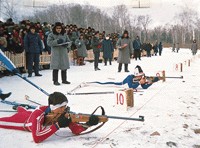1) two-phase anaerobiosis


两项厌氧
2) two-phase anaerobic


两相厌氧
1.
Experiment research on two-phase anaerobic digestion of folded plate;


折板两相厌氧消化工艺的试验研究
2.
Application of two-phase anaerobic in pulp wastewater treatment;


两相厌氧在浆粕废水处理工程中的应用
3.
The Study on Mesophilic Two-phase Anaerobic Degradation System in Industrial Phenolic Wastewater Treatment;
中温两相厌氧生物系统处理苯酚废水试验研究
3) two phase anaerobic process


两相厌氧
1.
Experiments on organic acids conversion in methanogenic phase of the two phase anaerobic process were conducted.
研究了两相厌氧系统产甲烷相中有机酸转化规律 。
4) two-phase anaerobic process


两相厌氧
1.
A comparative experiments were done by homogenous anaerobic and two-phase anaerobic process,which radicates the feasibility by two-phase anaerobic process treating wastewater from acrylic fibres.
采用单相和两相厌氧方法,对干法晴纶废水的处理进行了对比试验,确立了两相厌氧方案的可行性。
2.
Based on the present situation of application of two-phase anaerobic process on Chinese traditional wastewater, this paper aimed to provide reference in this field using the process through experiment by focusing on the characteristic of lack of seed sludge, slow start-up and difficult control of the pr.
本文立足于两相厌氧技术处理中药废水的应用现状,针对两相厌氧系统种泥缺乏、启动慢、工艺调控难的特点,进行试验研究,为两相厌氧工艺在中药废水处理领域的运用提供参考依据。
5) two-phase anaerobic digestion


两相厌氧消化
1.
Start-up experiment of pilot-scale mesophilic two-phase anaerobic digestion of mixed sludge;
混合污泥中温两相厌氧消化中试的启动试验
2.
The mesophilic(35 ℃) two-phase anaerobic digestion(TPAD) process was used to treat mixed sludge from primary sedimentation and secondary sedimentation tanks(1 ∶1) to realize sludge stabilization.
采用中温(35℃)两相厌氧消化工艺处理初沉污泥与剩余污泥的混合样(1∶1),以实现污泥的稳定化。
3.
The principle of two-phase anaerobic digestion(TPAD),the method of phase separation,affecting factors and evaluation indexes as well as the present situation of their researches and application both at home and abroad are described systematically in this paper.
论述了两相厌氧消化(TPAD)的原理、相分离的方法、影响因素和评价指标及国内外研究应用现状,展望了在废水处理领域中的广阔前景。
补充资料:现代冬季两项
| 现代冬季两项 biathlon 越野滑雪和射击相结合的雪上运动项目。由冬季滑雪狩猎和军队训练演变而来。男女项目分别在1960年和1992年列入冬季奥运会比赛。男子项目有 10千米越野滑雪加2次射击,20千米加4次射击,4×7.5千米加2次射击接力 。女子项目有7.5千米加2次射击,15千米加3次射击,3×7.5千米加2次射击接力。中国从1960年开始在解放军滑雪队中开展此项运动,1980年首次参加了第十三届冬季奥运会现代冬季两项的比赛。比赛方法以20千米比赛为例,比赛包括20千米越野滑雪加4次射击。运动员单个出发,随身携带枪支和20发子弹。每人每一射击点射5发子弹,如脱靶 ,每发子弹加罚一分钟。第一圈和第三圈滑行后卧射;第二、四圈滑行后立射;第五圈滑行直达终点。记时方法,将从起点到终点的时间,加上根据射击中靶情况决定的加罚时间为该运动员的总时间。滑雪用具与越野滑雪相同。武器是5.6毫米小口径专用步枪,子弹是专用小口径步枪弹,枪的扳机引力不得小于0.5千克。根据比赛项目的距离长短,可设3~5段滑行路线。起终点可设在射击场附近。射击场射击距离为50米,靶台用雪铺压而成。射击靶板为白色,靶板孔为黑色。机械靶卧射靶环直径为4.5厘米,立射靶环直径为11厘米。滑行路线设在丘陵起伏地区,高度差最大限度在200米以内。
|
说明:补充资料仅用于学习参考,请勿用于其它任何用途。
参考词条
